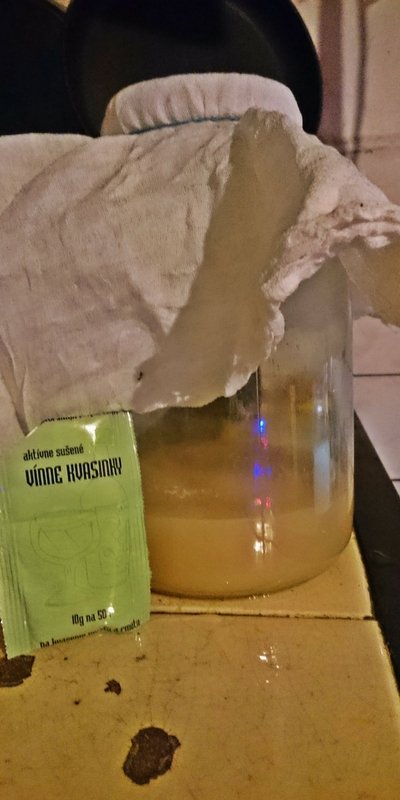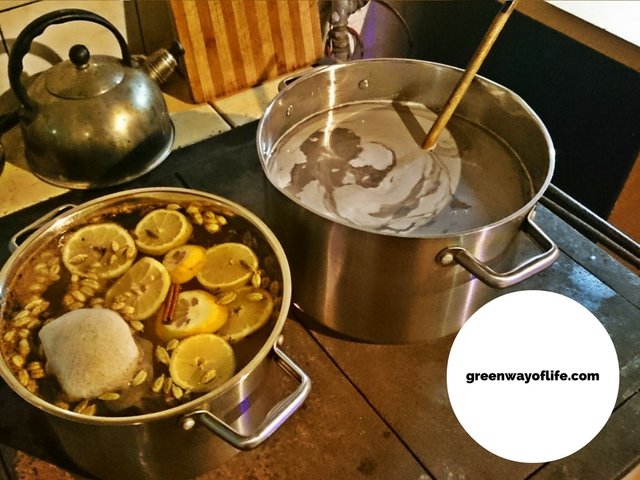MEAD: Delicious beverage made of honey - Recipe
Before we started making mead it was for us like one big alchemy..
But finally we decided, that it's so nice time spended in kitchen..
Play with honey and herbs in a beautifully scented cloud from all the ingredients :)
It's really pity, that nowadays people don't have so much chance to buy really quality mead..
That' s why we want you to learn, how to do it at home..
Step by step, easily :)
Of course, this is just ONE of many recipes on our planet and next time you do your own mead,
We are sure you will try to make your own experimentations.
Somebody likes clear, dry mead, similar to dry wine, others like sweet and coloured one.
What you need for 15l of mead is:
- About 5-10kg of honey (best is directly from your beekeeper - no additives, no chemistry..)
- Dry herbs - one handful of clove, cinnamon, cardamom, star anise and handful of elderberry flower
- Citric acid
- Wine yeast
- Nutritive salt (ammonium phosphate)
- Two big pots (10l) and one small
- Funnel
- Hose
- Sifter or piece of cloth
- Fermentation cork lock
- Carboy (20l) , two for faster pouring later
First step - broth
Boil 100g of honey with one liter of water in a small pot. Then cover it and let it cool down (from boiling to around 30°C). When temperature is ok, add one small spoon of wine yeast and pour it into glass jar.
Mix it, cover and let it on warm place around 20-25°C (when it's too cold, yeast is not working, if it is too hot, you kill it).
Wait three days - if there is foam inside jar, it's good, they are alive :)

Second step - cooking
Take one big pot - put all the honey inside and add water to get full pot (for sure let some free space for foam). Cook it for one hour and meanwhile take the foam out.
Why I have to cook the honey?
As you know, honey is very healthy. The special power of honey will not allow the fermentation process. If you want to achieve fermentation, you will have to kill the honey or experiment with different yeast, amounts of sugar, helping the fermentation cultures to survive the antidotes of honey.
In second large pot, cook herbs in 5 litres of water. It must not boil, so cook it on low or medium fire.


After one hour (And all the foam outside) stop cooking and let it cool down to 40°C.
The same with herbs.

Meanwhile, dissolve one spoon of citric acid in 5 litres of cold water poured into carboy. When herbal water and honey water have around 40°C, fill it into carboy with citric acid water.
Mix it and wait until measured temperature - it must have 25-27°C.
When temperature is ok, take prearranged broth and pour it inside the carboy. Shake it well. Last ingredient is small spoon of nutritive salt. Shake it last.
Enclose the carboy with sterile fabric and fix it well to prevent anything come in.
Carboy with mead must stay on warm place (also around 25°C).

Third step - stormy fermentation
This step should come in 3-5 days.
Change the fabric and close the carboy with cork fermentation lock, do not forget to add water into the lock.
Let it ferment for 6 weeks.
This step is just about waiting, mixing and watching :)
Fourth step - tapping mead
After stormy fermentation we want to clean it.
Using elastic tube we will replace mead into a new carboy.
Put new carboy on the floor.
Put full carboy in the chair.
Take the elastic tube and attach wooden skewer at one end using rubber end, so it works like a stabilization and protection against too low level - on the bottom is the part we no longer want - dead yeast etc.
Pour the young mead using physical law.
Enclose new carboy using fermentation lock and place it into cellar or another cold and dark place (temperature around 12°C) - Let it mature the fermentation process. It takes 3-6 months (depends how much yeast and sugar stay in mead).
Fifth step - final tapping
Yahoo, here we are! After few months we can finally pour mead from carboy into bottles and taste it. Perform this step again with rubber tube, funnel and sifter (or cloth) and be also careful about mess on the bottom (it there is something).
Every tool must be perfectly clean.
Enjoy this nice process and your very own home made product :))
Perfect as it is, cold or hot. Also wonderful in beer, this is called "Korma" in our country and it is powerful.
Do you have your own recipe? Please let us know!
Sounds awesome !!
I like you showing how you did it. Those glass carboys are really look neat -- not like any that I've seen before.
There's an unending argument over whether or not to boil the honey itself in the must, or to simply boil any additives (fruits, spices, etc), so this is just my opinion.
In my first few years of brewing I did boil the must, then the long cooling process, then pitching my yeast. In the last several years I've stopped boiling it, and I believe the flavor after fermentation is better. Heating honey past 118°F/ 48°C decreases the specific gravity, increases the Ph, and eliminates some probiotics and enzymes. However, none of this has an effect on fermentation, which is why the unending argument.
Yeah, I do not boil. /boggle That's horrible. You're killing the natural yeast in the raw honey that way too. I want those things like the probiotics and enzymes in the mead on purpose for health benefits.
Please let me know when you're posting a quality reply like this one Jeff, and I will help by upvoting it. :)